

What’s A Startup? First Principles. Success consists of going from failure to failure without loss of enthusiasm.
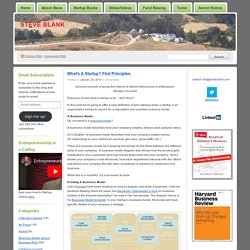
Winston Churchill Everyone knows what a startup is for – don’t they? In this post we’re going to offer a new definition of why startups exist: a startup is an organization formed to search for a repeatable and scalable business model. A Business ModelOk, but what is a business model? A business model describes how your company creates, delivers and captures value. Or in English: A business model describes how your company makes money. Think of a business model as a drawing that shows all the flows between the different parts of your company.
Super successful companies. I spent some time recently thinking about what companies that grow up to be extremely successful do when they are very young.
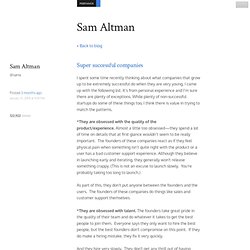
I came up with the following list. It’s from personal experience and I’m sure there are plenty of exceptions. While plenty of non-successful startups do some of these things too, I think there is value in trying to match the patterns. *They are obsessed with the quality of the product/experience. Almost a little too obsessed—they spend a lot of time on details that at first glance wouldn’t seem to be really important.
As part of this, they don't put anyone between the founders and the users. *They are obsessed with talent. And they hire very slowly. As part of this, they really focus on getting the culture of the company right. *They can explain the vision for the company in a few clear words. More generally, they communicate very well. *They generate revenue very early on in their lives. *They are tough and calm. *They keep expenses low. *They grow organically.
Customer Dev + Prototyping (Bizspark day mai 2011) 20 ways to validate your startup idea (other than landing pages) I was invited along to do a talk and mentor the teams at last weekend’s Lean Startup Machine in London.
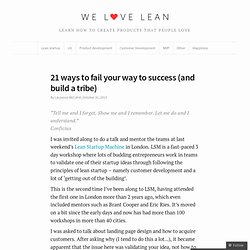
LSM is a fast-paced 3 day workshop where lots of budding entrepreneurs work in teams to validate one of their startup ideas through following the principles of lean startup – namely customer development and a lot of ‘getting out of the building’. This is the second time I’ve been along to LSM, having attended the first one in London more than 2 years ago, which even included mentors such as Brant Cooper and Eric Ries. It’s moved on a bit since the early days and now has had more than 100 workshops in more than 40 cities.
I was asked to talk about landing page design and how to acquire customers. After asking why (I tend to do this a lot…), it became apparent that the issue here was validating your idea, not how to design a landing page design per se. So I took my brief as to help the attendees consider ways you can test out your startup idea, or even come up with better ones.
Lean Design Thinking. Lean Startup. Business Model. Start With a Business Model, Not a Business Plan - The Accelerators. Problems Don't Exist by. I have long held the belief that entrepreneurs should stop talking about abstract solutions and frame their pitches in terms of solving real problems, but I was wrong.
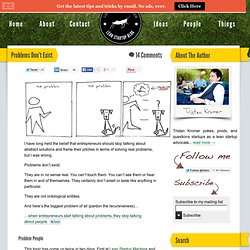
Problems don’t exist. They are in no sense real. You can’t touch them. You can’t see them or hear them in and of themselves. They certainly don’t smell or taste like anything in particular. They are not ontological entities. And here’s the biggest problem of all (pardon the recursiveness)… …when entrepreneurs start talking about problems, they stop talking about people. Problem People This topic has come up twice in two days. But problems are nouns, and that’s a bad thing. It is an uncomfortable holdover of platonic philosophy that the Western world treats abstract concepts and relationships as entities that can be manipulated as independent objects. « L’actif de la start-up est l’apprentissage qu’elle fait de ses fausses routes » XEnvoyer cet article par e-mail « L’actif de la start-up est l’apprentissage qu’elle fait de ses fausses routes » Nouveau !

Pas le temps de lire cet article ? Les 36 questions à vous poser lorsque vous démarrez votre projet de création d’entreprise… – Customer Development – Customer discovery. Par Guilhem Bertholet Par où commencer ?
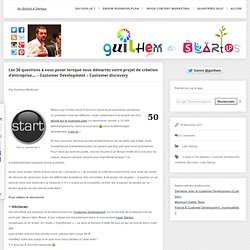
Beaucoup d’entre vous m’écrivent dans leurs premières semaines ou premiers mois de réflexion, suite notamment à la lecture de mon ebook sur le business-plan (on terminera l’année à 15.000 téléchargements, merci à vous tous (pour le télécharger directement, c’est ici) ! Et bien souvent, les tous jeunes entrepreneurs (je ne parle pas d’âge, mais d’expérience entrepreneuriale) ne savent pas trop par quel bout commencer. Aller à la pêche aux informations chez vos clients – Customer Development. Comme vous le savez – le suspense est insoutenable, je sais – je remonte une boîte, avec l’équipe et sans l’idée.

Bon, ok, maintenant on commence d’affiner un peu et on se met doucement en mouvement. Et pour cela, nous suivons avec Guillaume les étapes du Customer Development, qui nous a fait poser quelques hypothèses sur notre vision et le premier produit que nous pourrions sortir. Next step : rencontrer le maximum de monde pour valider, modifier, invalider, bouger les hypothèses. Sxsw New Rules for the New Bubble 031211.